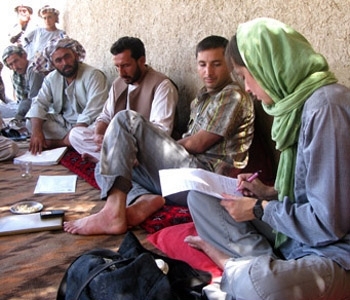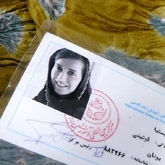War is always brutal, but the violence that erupts during civil war seems to bring out the worst of the worst in humankind. The specter of slaughter of neighbor by neighbor — in the Balkans, Afghanistan, Rwanda, Uganda and elsewhere — can lead us to believe that ethnic, religious, and cultural diversity is a deadly tinderbox, ever vulnerable to sparks, no matter how long groups have lived peacefully side by side.
Fotini Christia, assistant professor in the Department of Political Science in the School of Humanities, Arts, and Social Sciences, challenges that world-weary pessimism. Through her intrepid field research with Afghanistan warlords, Christia has steadily analyzed the personal, political, and cultural forces that cause a regional or tribal leader to take up arms against a neighboring group, and what allows that same leader—sometimes with mind-boggling rapidity — to put aside the guns and embrace a former enemy.
Christia finds that under certain conditions, even groups sworn to take revenge on one another can overlook longstanding grievances and form new, supportive alliances.
What Can Turn Enemies into Allies?
What is the key? Whatever gives a group a strategic military or economic advantage — even if the action drives them into the arms of their supposed enemies.
“Groups are driven by balance-of-power considerations,” says Christia. “That means that, as relative power changes, so do alliances. Groups then come up with narratives and stories about why they make the alliances they do.”
For example, leaders may rail at a competing group, painting them as implacable or traditional long-time foes. After an alliance is reached, leaders develop a new narrative, now telling stories that portray their former enemies as worthy opponents or long-lost brothers now welcomed into the fold of a new union.
"Fotini understands what was really going on, and what factors were at play in Afghanistan, much better than anybody I’ve seen in the academic world.”
— Admiral William Fallon, Former director, U.S. Central Command
Finding a story
“They can always find a story,” Christia observes. Allying groups may focus on their common language or religious characteristics — those stories tend to be “stickier” or more potent she says. “If they don’t share any of those traits, they move to ideological characteristics (‘We were both jihadis!’) If they don’t share those, they move to economic characteristics (‘We were both nomadic tribes.’) If they can’t find that, they find a shared enemy story. ” Many mainstream media reporters and pundits assume that groups define themselves solely and immutably by ethnicity, culture, religion, or geography. But Christia’s work shows that a host of local power dynamics may be at play establishing group identity in the Near East and elsewhere. Perception of ethnicity, religion and even geography are far more fluid, when political or economic power could be gained by broader definitions. Even a group’s fierce ideology, Christia says, “doesn’t lead to some non-changing equilibrium.”
A native of Greece, Christia studied at Columbia and Harvard before coming to MIT in the fall of 2008. The research for her dissertation, “The Closest of Enemies: Alliance Formation in the Afghan and Bosnian Civil Wars,” has profound implications for U.S. foreign policy in the Near and Middle East. A more open-ended and regionally sensitive approach to confronting enemies and creating allies could prove beneficial both to U.S. interests and long-term stability in Afghanistan, she believes.
Christia’s theories have drawn the support of Admiral William Fallon, who led the U.S. Central Command from March 2007 to March 2008, during which time he directed all U.S. military activities in the Middle East, Central Asia, and the Horn of Africa. Admiral Fallon met Christia while he was the 2008-09 Robert E. Wilhelm Fellow with the School-based Center for International Studies.
“If there’s one thing I learned in the Near and Middle East,” Fallon says, “it’s how rapidly conditions change and how people adapt to them. Fotini understands what was really going on, and what factors were at play in Afghanistan much better than anybody I’ve seen in the academic world.”
Read the full story in Soundings Magazine
Fotini Christia, assistant professor in the Department of Political Science in the School of Humanities, Arts, and Social Sciences, challenges that world-weary pessimism. Through her intrepid field research with Afghanistan warlords, Christia has steadily analyzed the personal, political, and cultural forces that cause a regional or tribal leader to take up arms against a neighboring group, and what allows that same leader—sometimes with mind-boggling rapidity — to put aside the guns and embrace a former enemy.
Christia finds that under certain conditions, even groups sworn to take revenge on one another can overlook longstanding grievances and form new, supportive alliances.
What Can Turn Enemies into Allies?
What is the key? Whatever gives a group a strategic military or economic advantage — even if the action drives them into the arms of their supposed enemies.
“Groups are driven by balance-of-power considerations,” says Christia. “That means that, as relative power changes, so do alliances. Groups then come up with narratives and stories about why they make the alliances they do.”
For example, leaders may rail at a competing group, painting them as implacable or traditional long-time foes. After an alliance is reached, leaders develop a new narrative, now telling stories that portray their former enemies as worthy opponents or long-lost brothers now welcomed into the fold of a new union.
"Fotini understands what was really going on, and what factors were at play in Afghanistan, much better than anybody I’ve seen in the academic world.”
— Admiral William Fallon, Former director, U.S. Central Command
Finding a story
“They can always find a story,” Christia observes. Allying groups may focus on their common language or religious characteristics — those stories tend to be “stickier” or more potent she says. “If they don’t share any of those traits, they move to ideological characteristics (‘We were both jihadis!’) If they don’t share those, they move to economic characteristics (‘We were both nomadic tribes.’) If they can’t find that, they find a shared enemy story. ” Many mainstream media reporters and pundits assume that groups define themselves solely and immutably by ethnicity, culture, religion, or geography. But Christia’s work shows that a host of local power dynamics may be at play establishing group identity in the Near East and elsewhere. Perception of ethnicity, religion and even geography are far more fluid, when political or economic power could be gained by broader definitions. Even a group’s fierce ideology, Christia says, “doesn’t lead to some non-changing equilibrium.”
A native of Greece, Christia studied at Columbia and Harvard before coming to MIT in the fall of 2008. The research for her dissertation, “The Closest of Enemies: Alliance Formation in the Afghan and Bosnian Civil Wars,” has profound implications for U.S. foreign policy in the Near and Middle East. A more open-ended and regionally sensitive approach to confronting enemies and creating allies could prove beneficial both to U.S. interests and long-term stability in Afghanistan, she believes.
Christia’s theories have drawn the support of Admiral William Fallon, who led the U.S. Central Command from March 2007 to March 2008, during which time he directed all U.S. military activities in the Middle East, Central Asia, and the Horn of Africa. Admiral Fallon met Christia while he was the 2008-09 Robert E. Wilhelm Fellow with the School-based Center for International Studies.
“If there’s one thing I learned in the Near and Middle East,” Fallon says, “it’s how rapidly conditions change and how people adapt to them. Fotini understands what was really going on, and what factors were at play in Afghanistan much better than anybody I’ve seen in the academic world.”
Read the full story in Soundings Magazine









